|
|
Japan evokes varied visuals to each individual. The imageries dwindle somewhere between the kimono-attired Japanese women, display of warm formality and etiquettes, hi-tech gadgets to the jet-setting speed of the monorail. Though it is the atomic devastation of Japan at Hiroshima and Nagasaki cities in 1945 that wrenched the hearts of people around the world, the country has left behind the dark days long back. Today it is the “Land of Rising Sun” in true sense. Geographically it is justified by Japan’s location on the extreme eastern end of Asian continent between the Pacific Ocean and Sea of Japan. In practical life, the island nation surpassed all expectations to emerge as one of the leading economies and technological giants of the world after the nuclear disaster in mid-twentieth century. Japan is an archipelago of nearly 3000 islands, Hokkaidō, Honshū, Shikoku, Kyūshū and Ryukyu being the most prominent ones. Tokyo is the capital city. Other important cities of Japan are Osaka, Nagoya, Kyoto and Yokohama.
Starting from Japan’s original and ancient Jomon culture to its contemporary high-end technical innovations, the country has evolved a lot without disturbing its rich and glorious past. Except for the attacks and invasions by United States of America and Russia during Second World War, the country’s history is bereft of any foreign rule or interference. The courageous tales of the Samurai warriors and skills of martial arts are omnipresent in every nook and corner of Japan. Politically, the country is considered to be a constitutional monarchy with actual powers resting on the national parliament. The economy has flourished with record margins of GDP on the basis of skilled labour force and market-oriented policies. Ethnic Japanese form the majority of the approximate population of 127,417,244. The minority communities consist of indigenous Ainu people, Chinese, Taiwanese, Filipinos, Koreans and Brazilians. Japanese is the official language of the country with most of the populace practicing religious faith of Buddhism and Taoism. Ikebana arts, Kabuki dance, pottery, Bonsai gardening and tea ceremonies highlight the cultural peripheries of Japan.
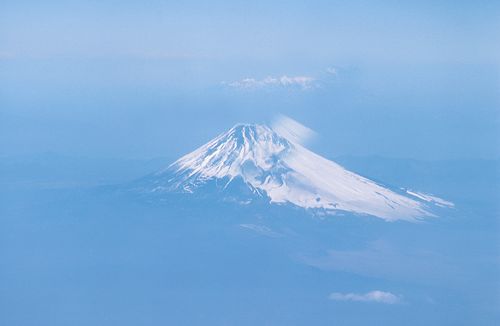 Mount Fuji
Mount Fuji
|
Geography
Japan is a conglomeration of about 3000 islands of different shapes and sizes on the eastern Asia. The waves of Pacific Ocean, the Sea of Japan, the Philippine Sea, the East China Sea, and the Sea of Okhotsk crash in its coasts from different sides. Off the coast neighbours of the country include South Korea on the west, Russian mainland to the north and China and Taiwan on the southwestern sides. Kyushu, Hokkaido, Honshu and Shikoku are the major and most inhabited islands among all, Honshu being the largest one with all the major cities in its territory. The other major island of Ryukyu is situated over 600 km to the southwest of Kyushu. Japan is spread over an area of 377,835 sq km and possesses a coastline of 29,751 km.
It is believed that thousands of years ago, these islands were part of the mainland Asia. Present-day lands of Japan got separated and scattered into island due to its positioning above the Pacific Ring of Fire, which denotes the meeting point of earth crusts like the Philippine Plate, Pacific Plate, Eurasian Plate, and North American Plate. This makes Japan victim of frequent earthquakes, volcanic eruptions, tsunamis and typhoons. All these natural hazards are complemented by the rugged terrain of Japan that is largely mountainous. Thus most of the islands are sparsely or not at all inhabited triggering the population density of the habitable islands. About seventy to eighty percent of Japan is occupied by hills and mountains, most of them being volcanic, thus hampering transportation. The highest and most famous of them is the snow-capped peak of Mt. Fuji. The Kanto Plain, Kinki Plain, Sendai Plain and the Nobi Plain are some of the fertile areas where the industries and cities like Tokyo, Kyoto are situated, leaving little space for agriculture. Other towns and cities are located into the flat lands along the coastal areas. There are also many short rivers, forested areas, small lakes and numerous hot springs in the city.
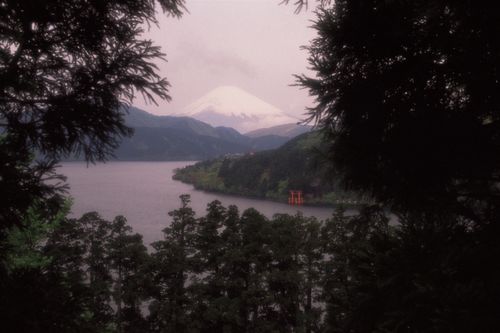 Mount Fuji and Lake Ashinoko
Mount Fuji and Lake Ashinoko
|
Climate
The long spread lay out of the islands of Japan from north to south attribute to the countries highly contrasting climatic conditions. The weather starts with chilling degrees in the north but the mercury rises while one travels down south. Humidity is high in the western regions of the main islands, with heavy rainstorms. The central regions also suffer same climatic fate. The oceanic currents influence Japan’s weather highly. On the Pacific coast the weather is less extreme.
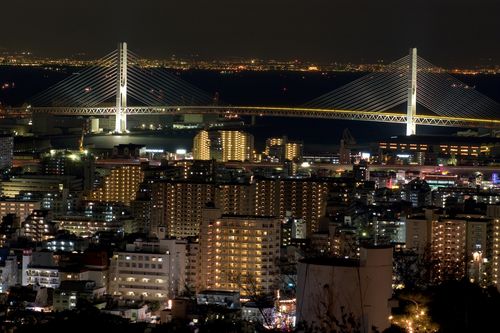 Night view of Kobe
Night view of Kobe
|
History
Japan is home to the longest surviving monarchy in the world and boasts of a history that seldom witnessed any foreign invasion. It was the sudden attack of Pearl harbour that Japan inflicted on the Naval Base of United States at Hawaii that caught the country in political storm. The turbulence ended with one of the worst incidents in world history, the August 1945 atomic bombing over Hiroshima and Nagasaki that pulled the iron curtain to Second World War.
Dating back to initial historic timeline, the regions of Japan have been inhabited since the Stone Age. The evidence of the Jomon culture is found in different style of pottery. Migrations from Korea continued from around 200 BC to 600 AD that established the Yayoi period. Rice farming, cloth weaving, metalworking and other advanced technologies became prevalent in this era. The Following Kofun era brought along the establishments of military services and all small states and cities came under one strong central power of Yamato court. The next centuries saw the influence of the Chinese writing system and Buddhism and emergence of the new capital city of Kyoto in 794. The Nara period of the 8th century was the most remarkable period of development for Japan.
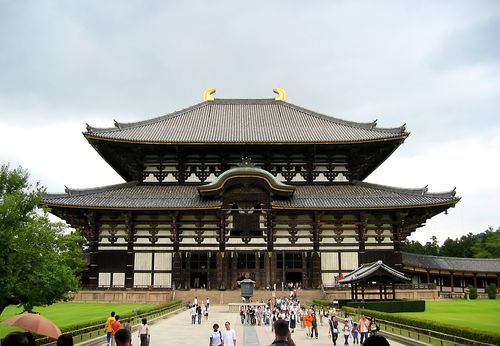 The largest wooden temple in japan at Nara
The largest wooden temple in japan at Nara
|
The Imperial rule of Japan came to an end in the last decade of tenth century with the real power passing on to the Shogun, the military commander. Yoritomo, the first Shogun, had his centre at Kamakura, near modern Tokyo and wielded power through his control over the warrior class, the Samurai. During the late thirteenth century, they ousted two Mongol invasions. The Shogun reign changed many families over the years that ensued civil wars. In 1603 the Shogun Ieyasu established his capital at Edo, known as Tokyo now. Portuguese traders were the first visitors from the west in 1543 followed by Dutch, British and Spanish merchants and missionaries led by Saint Francis Xavier. But Japanese feared political and religious invasion and Tokugawa Shogunate stopped further foreigner visits in Japan. The Emperor Meiji took control of Japan from the Shogun in 1868, moved his capital to Edo, renaming it Tokyo. Japan opened up to the outside world with the arrival of Commodore Perry, from the USA.
In the next few decades, Japan went to war with China, winning Taiwan. In 1910, Japan defeated Russia, capturing more territory and annexed Korea. In the First World War, Japan stood by the Allied forces but grouped with Axis powers of Germany in the second one. After the nuclear debacle, Japan came under influence of American administrative reign and became a trusted ally. Today, Japan is a member state of the United Nations, the G8, and the G4 nations and is dependent on U.S. over defence forces.
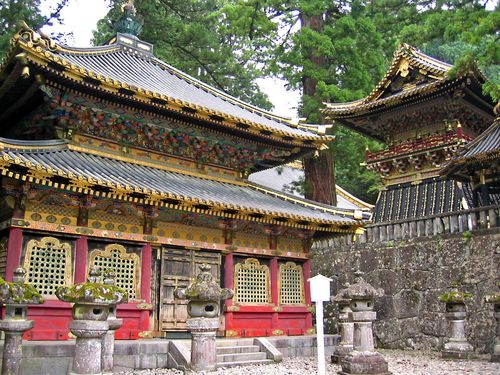 Toshogu temple at Nikko
Toshogu temple at Nikko
|
Economy
Japan is a remarkable economic success story. From the beginning of the twentieth century, Japan progressed rapidly with thorough industrialisation, textiles manufacturing, light goods production and establishments of heavy industries. The devastation of Second World War hindered the uprising of growth but it recovered quickly capitalising on its huge skilled labour force, efficient government policies and competent work environment. By the 1970s it had become the most industrialised country in Asia and the second greatest economic power in the world after the United States. Electronics industry of Japan is considered to be the global leader. Manufactured goods make up the vast majority of the nation's exports. Amazingly, these profits are achieved despite being dependent on import of all raw materials required for production. Japan has also become a global leader in financial services, with some of the world's largest banks. However, the downfall of Asian trade and commerce in late twentieth century and over-zealous Japanese investment pattern slowed down the economic growth a bit. Agriculture in Japan accounts for only 2% of the GNP. Fishing is highly developed, and the annual catch of Tuna fish is one of the largest in the world. The services, transportation and finance sectors absorb large number of the work force.
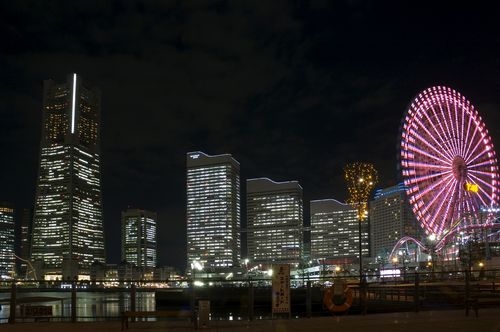 Yokohama at night
Yokohama at night
|
Politics
Japan is a constitutional monarchy with a parliamentary government. The political structure of the country is based on the constitution of 1947 and the regular functioning of affairs resembles the British monarchical system. The constitution declares that the emperor is the “symbol of the state” but his activities are restricted to ceremonial presence only. However, he is the most popular figure in the country. Hirohito was the emperor from 1926 until his death in 1989 and was succeeded by his son, Akihito, the present emperor. The sovereignty rests with the people of Japan who elect the members of the bicameral parliament, National Diet. The constitution regards it as the "highest organ of state power" and Japan's sole investor of legislative power.
The Diet is composed of the House of Representatives, a body of 480 members elected for a term of four years. The House of Councillors has 242 members who are elected for terms of six years. Executive power is vested in a cabinet appointed and headed by the prime minister, who is elected by the Diet and is usually the leader of the majority party in the parliament. A supreme court heads an independent judiciary. The monarch appoints the chief justice of Japan after nomination by the cabinet. The cabinet appoints all other justices.
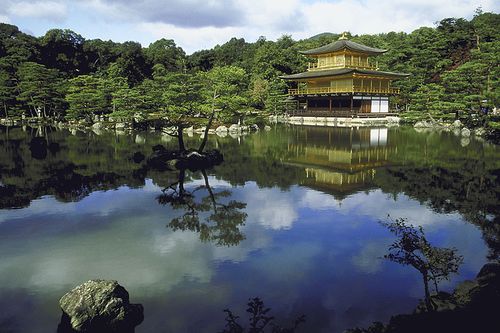 Kinkakuji Temple, Kyoto
Kinkakuji Temple, Kyoto
|
|
|

